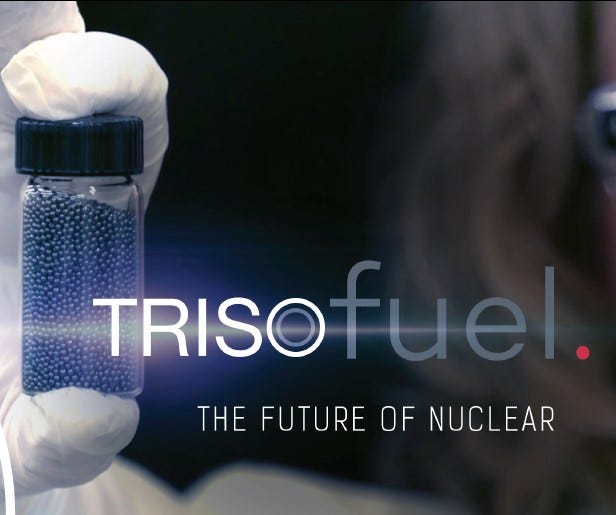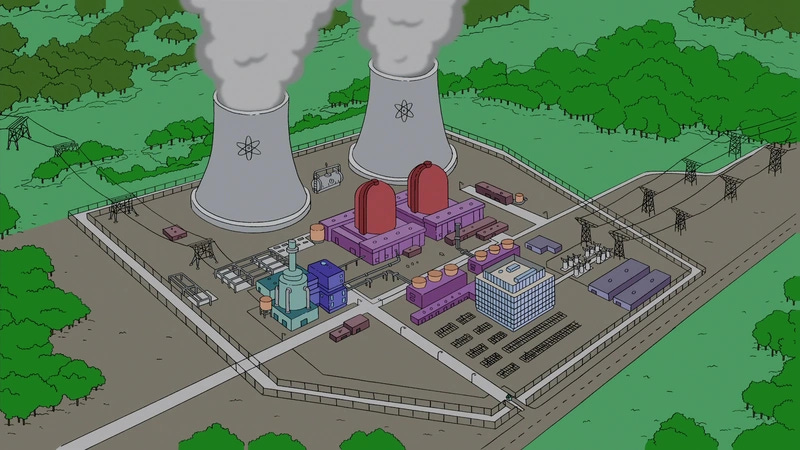Nuclear Meltdown
Stop Fueling the Fear
Welcome to Polymathic Being, a place to explore counterintuitive insights across multiple domains. These essays take common topics and investigate them from different perspectives and disciplines to come up with unique insights and solutions.
Today's topic attempts to energize interest in an incredible technology that many view negatively; Nuclear Power. We’ll introduce the cutting-edge advances in energy production, miniaturization of reactors, massive safety improvements, and best of all, the wonderful environmental benefits that nuclear can offer us in the future.
Introduction
Let’s be honest, the main impression most of us probably carry about nuclear energy is a bubbling cauldron of hazardous waste just waiting for some mutant creature to emerge and destroy humanity.

Other images like the dystopian aftermath of Chernobyl don’t help the perspective:

This wasn’t helped by a backlash in the 1970s where prominent technologists such as Paul Ehrlich and Amory Lovins openly stated:
Ehrlich: “In fact, giving society cheap abundant energy at this point would be the equivalent of giving an idiot child a machine gun.”
Lovins: “If you ask me, it’d be a little short of disastrous for us to discover a source of clean, cheap, abundant energy because of what we would do with it.”
This sort of fear of advanced technology was recently discussed by Matthew Yglesias of the Slow Boring regarding The Techno-optimists Fallacy. This essay can be summarized that while technology has driven much our our human betterment that doesn’t mean that technology will always lead to better results.
While this was authored concerning the recent over-exuberance of AI it also parallels the challenges of balancing the amazing potentials of technology against their risks. (We’ve talked about this extensively here on Polymathic Being)
I’m what you might call a techno-pragmaticist and have worked for most of my professional career to balance technology with human considerations. For example, at Lockheed Martin, I was heavily involved in AI Ethics specifically focused on ensuring trust and safety of autonomous, AI-enabled systems.
Yet for nuclear energy, many of the fears are largely outdated and have always been inflated far beyond the reality of the situation. This essay will look at the history of nuclear power and then update our knowledge of the current technologies, improvements, and potentials to power our future.
Contextualizing the Dangers
Chornobyl fills our general consciousness as a clear indication of the risk of nuclear power. Yet this wasn’t a failure of nuclear per se but a larger failure of the Soviet culture at the time which did not broker an ability to push back on bad ideas. The disaster was a product of a flawed reactor design, poor safety culture, and serious mistakes by Chornobyl staff.
As a counter-example to the failures of Chornobyl is the United States’s own Three Mile Island scare. It demonstrated a problem that was well responded to and mitigated. Yet it still became synonymous with the dangers of nuclear, ironically, because the US was so open and transparent about the situation. Ultimately, Three Mile Island emitted less radiation to the population than we are exposed to on a cross-country airplane ride.
More recently Fukushima elevated enough fears that nations like Germany vowed to close down their reactors. Yet this fear creates consequences even worse than anything nuclear energy has done in history. First, it created a dependency on Russian natural gas and with the recent war in Ukraine, Germans have turned back to burning coal and wood for heat.
The irony of the Fukushima fears is twofold:
They built the reactors on the coast in a region known for seismic activity and a history of tsunamis. It’s oddly hubristic to think that was a safe option.
The actual contamination was much less than we were led to believe initially and the result has been nearly a rounding error in radiation pollution. (it should also be noted that Fukushima was much less environmentally damaging or polluting than the tsunami writ large)
Most of our ideas of nuclear energy are nearly half a century out of date and involve archaic designs, ancient fuel technologies, and fears about realized events that were blown out of proportion. We view nuclear as especially dangerous to humans and yet, it’s actually saved millions of lives.
For example, air pollution from fossil fuels is responsible for an estimated 7 million deaths per year while nuclear carries about the same risk as wind power and is around 350 times safer than coal. Going back to Germany, while Fukushima has no acute radiation deaths, German coal burning has been estimated to have killed thousands since they turned off their nuclear reactors.
Further let's consider the nuclear powered navy. To quote Wikipedia:
Since its inception in 1948, the U.S. Navy nuclear program has developed 27 different plant designs, installed them in 210 nuclear-powered ships, taken 500 reactor cores into operation, and accumulated over 5,400 reactor years of operation and 128,000,000 miles safely steamed
These fears also don’t take into consideration the incredible advancements in performance, safety, fuel, and size reduction that have occurred over the past 40 years.
Small Modular Reactors
What many don’t realize now is that the idea we have of a nuclear reactor like the Simpson’s TV show is an archaic relic of the past. Most of us would never even know a nuclear plant exists today due to the dramatic improvements in design.
How dramatic you ask? Well, they currently have microreactors that can fit in a shipping container in a footprint smaller than a house. These reactors can produce between 5 and 10 megawatts which can power over 2000 homes.
You can distribute these reactors nationwide and provide focused, resilient, and agile power generation to more easily balance wind and solar projects. Conversely, the large and centralized power generators today, nuclear or otherwise, require extensive power grid infrastructure to carry and distribute that volume. Small Modular Reactors require much less intensive delivery infrastructure and are less prone to disruption.
New Fuel
One of the coolest innovations in nuclear technology was driven by the US Department of Energy's investments in stable, safer, and modular fuel sources. Leading the pack is Triso Fuel which are tiny kernels of nuclear fuel surrounded by multiple protective layers. You can hold a handful of these tiny beads and be at negligible risk of any danger.


This fuel works when massed together and activated. It’s a marvel of design with orders of magnitude improvements in safety and disposal. Simply put, it’s a game changer.
How Safe is This?
A few years ago I was the lead researcher for Lockheed Martin investigating Westinghouse’s eVinci™ Microreactor for the US Strategic Capabilities Office Pele project. My role was to assess the technology specifically related to putting these reactors in combat locations overseas.
Sounds crazy right? We’d put a nuclear reactor in a combat zone!!?
Well, the issue is that we need an enormous amount of power in combat to run our advanced technology systems, radios, computers, etc. That power is currently produced using diesel generators by and large. This is exceptionally inefficient, environmentally unfriendly, and has an insane logistic burden to keep them maintained and fueled. These supply lines are especially vulnerable to attack specifically in the counter-insurgency wars we’ve fought the past 20 years.
One of the biggest concerns of a nuclear reactor in combat is the potential for it to be destroyed and the risk of a catastrophic nuclear event. However, my analysis demonstrated that this isn’t even a concern. Ironically, the fastest way to turn off a micronuclear reactor running Triso fuel is to blast it to smithereens. As you distribute the tiny beads of fuel, the reaction stops and the radiation is distributed to shockingly low levels.
Yes, a direct hit is actually not that big of a deal. The rest of the safety controls mean you can successfully power the system down under quite adverse conditions and, if necessary, render it inoperable. I should clarify that these systems would not be deployed to the front lines of combat but in the logistics and command and control areas in the rear of the fight. Yet, even in a worst-case scenario, you can remove a reactor in 24 hours by road (due to heat) or 96 hours by air.
The small modular reactors are so stable that you can legitimately deploy them into a warzone to provide distributed, consistent, and clean power in one of the most hostile environments you can imagine. Just think of what you could do to improve domestic power production.
Conclusion
The capabilities of these systems applied to our civilian power grids, are only limited to our imaginations. Reactors could be distributed across the grid reducing infrastructure. They would then provide improved resiliency in our power generation where weather events, technical issues, or even cyber attacks wouldn’t take down entire regional grids. These reactors would help buffer and stabilize wind and solar projects where additional reactors could be spun up and back down based on changes in power demand.
Most importantly, we’d be able to phase out our coal-fired plants, reduce our burning of natural gas, and convert our grid to less polluting, more efficient, more stable, and cheaper power than we currently have. There’s just so much upside today!
It’s time to stop melting down about nuclear energy and realize that we have advanced the technology beyond anyone’s imagination, have increased the safety to a degree that few can comprehend, and have a tool on hand to combat our CO2 emissions while powering the entire world.
Enjoyed this post? Hit the ❤️ button above or below because it helps more people discover Substacks like this one and that’s a great thing. Also please share here or in your network to help us grow.
Polymathic Being is a reader-supported publication. To receive new posts and support my work, consider becoming a free or paid subscriber.
Further Reading from Authors I really appreciate
I highly recommend the following Substacks for their great content and complementary explorations of topics that Polymathic Being shares.
Goatfury Writes All-around great daily essays
Never Stop Learning Insightful Life Tips and Tricks
Cyborgs Writing Highly useful insights into using AI for writing
One Useful Thing Practical AI
Educating AI Integrating AI into education








I always maintained that if climate activists dismiss getting nuclear power plants built to supply clean energy to their citizens then they’re not really climate activists.
Michael - interesting article and important topic of discussion. I served on nuclear powered submarines in the Navy for years. I trust the technology implicitly. Like anything, it needs to be handled with care and by trained professionals. But the Navy's nuclear power program has been running strong for years without any nuclear incidents. And on a submarine you are always within 300 feet of a running reactor. I don't know anyone who has sprouted a third eye on their forehead.